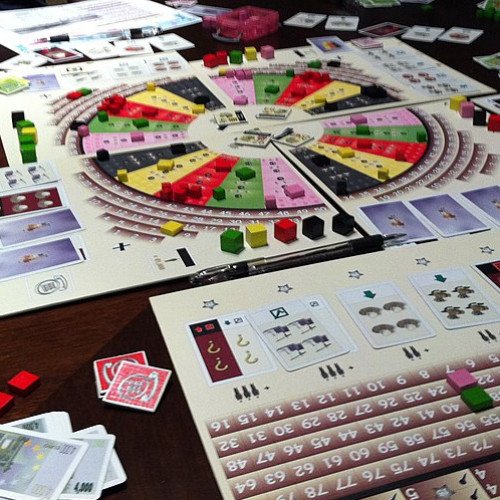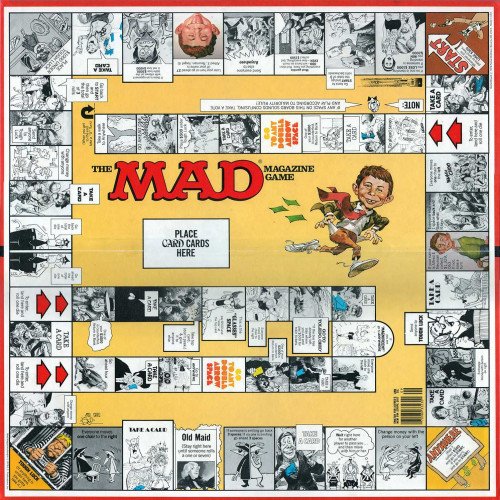"DIE MACHER" vs "THE MAD MAGAZINE GAME"

DIE MACHER
Die Macher is a strategy board game published by Hans im Glück in 1986 that simulates a German general election. Die Macher ("The Maker") was designed by Karl-Heinz Schmiel of Germany, and published by Hans im Glück in 1986 as a four-player game. The original edition used only the Länder (German states) of the former West Germany, and featured political issues relevant to the mid-1980s. A revised version of the game with more professional production values was released in 1998. It added the Länder of eastern Germany, a fifth party (the PDS, the successor of the East German SED), updated the issues to those of the 1990s, and extensively changed the rules. It was nominated for the 1998 Spiel des Jahres (Game of the Year) award. In 2006, Valley Games of Canada produced a new version of the game, with language-independent components, revised issues, the PDS renamed to Die Linke, and a few minor rules changes. The game is based on the German electoral system. Each player takes the role of one of the major German political parties. In the 1986 edition, these were the CDU/CSU, FDP, SPD, and the Greens. In the 1998 version, a fifth party, the PDS, was added. In the 2006 edition the PDS was renamed Die Link. Parties score points based on seats won in seven state (Land) elections, the size of their national party base, the amount to which they control the national media, and how well their party platform aligns with national opinion. Each state election is a "mini game" on its own. Each state has its own interests (such as "do we support higher taxes, or not?"), and a party will do better if its platform aligns with the local concerns. Players can deploy a limited number of "party meetings" (groups of grassroots activists) to a state; the more they have there, the more votes they will generate when the election is resolved. "Shadow Cabinet" cards, representing influential party officials, can be used to perform some special actions, and each party tracks its "trend" (favorability rating) in the state using a sliding scale. When the election is held, each party scores votes based on the formula (trend + interest alignment)* (number of meetings). A maximum score is 50, and parliamentary seats (victory points) are awarded based on this score and the state's actual number of seats in parliament. The seven states are chosen at random from the sixteen Länder of Germany, so some elections will be more influential than others. Players can modify their party's' platform and by controlling the local media can also affect what the state is concerned about. Winning the local election allows the party to advance their media control to the national level and to help outline the national issues list. Players see the elections developing in advance and can apply their resources to the current election or upcoming ones, adding to the difficult decision making. During each state election, parties can agree to, or be forced into, coalitions, and share in any victory. Parties must also decide whether or not they will accept contributions from special interests with the possibility of alienating their grassroots donor base.
Statistics for this Xoptio

THE MAD MAGAZINE GAME
The Mad Magazine Game, also known as Mad Magazine: The "What-Me Worry?" game, is a board game produced by Parker Brothers in 1979. Gameplay is similar, but the goals and directions often opposite, to that of Monopoly; the object is for players to lose all of their money. Play proceeds to the first player's right and the first player is determined by a left-handed roll for the lowest number. The game includes cards, money, dice, and tokens, and the game board features Alfred E. Neuman and illustrations from Mad magazine. By design, no conclusive strategy exists for the game, since even if a player is winning, several spaces and cards direct players to exchange money or chairs with others, causing advantages to be lost instantly. To begin the game, after placing all tokens on Start and determining the first player, one player is selected to be the Banker ("preferably someone honest"), who gives $10,000 to each person. The dice may only be rolled with the left hand (giving no instructions on how those who physically cannot may roll the dice); a player using his/her right hand is penalized by receiving $500 apiece from all other players. Also, tokens move counterclockwise around the outside track. If moving clockwise, the player is informed that he or she is a nerd person and may never play the game again. The board contains two "inside track" sections, which can only be entered by landing on one of the double-arrow spaces leading onto them. A player who does so immediately takes another turn by rolling one die; while on an inside track, players may only roll one die. The cards and spaces bear a variety of bizarre directions, such as trading places or money with a particular opponent, winning or losing money based on what the other players are doing, or losing money by performing a comical stunt. If any disputes or ambiguities arise concerning the directions, they may be resolved by majority vote; in addition, if any questions come up concerning what constitutes a majority, the rules allow for them to be settled by majority vote. A player who lands on the "Tough Luck" space must take all the money that has accumulated there.